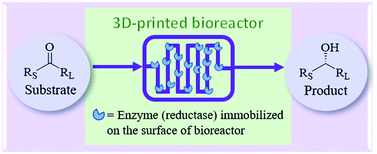Facile mussel-inspired polydopamine-coated 3D-printed bioreactors for continuous flow biocatalysis†
Abstract
Continuous flow biocatalysis has been a challenge in the biocatalysis area. To enable flow biocatalysis, enzyme immobilization techniques, as well as support materials, have been studied. Herein, this research employed a 3D printer, mussel-inspired polydopamine (PDA), and an enzyme to create PDA-coated 3D-printed bioreactors for continuous flow biocatalysis. Both batch and microfluidic bioreactors were fabricated using a 3D printer, functionalized by PDA, glutaraldehyde, and polyethylenimine, and thereby used for enzyme immobilization. This research used a novel and robust alcohol dehydrogenase, an acetophenone reductase from Geotrichum candidum (GcAPRD), as an enzyme model. First, we succeeded in immobilizing GcAPRD on the PDA-coated 3D-printed batch bioreactors. The immobilized GcAPRD could be recycled up to 4 times to reduce acetophenone with excellent enantioselectivity (ee > 99%, S). Next, continuous flow processes were successfully established using the PDA-coated 3D-printed microfluidic bioreactors with immobilized GcAPRD. The reduction of acetophenone proceeded smoothly to produce an enantiopure alcohol, (S)-1-phenylethanol, with excellent enantioselectivity up to 117–144 h. These findings opened up a new step in flow biocatalysis development, which has the feasibility of scaling up for further industrial uses.



 Please wait while we load your content...
Please wait while we load your content...